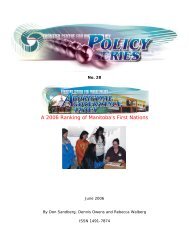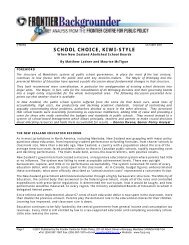POLICYSERIES - Frontier Centre for Public Policy
Create successful ePaper yourself
Turn your PDF publications into a flip-book with our unique Google optimized e-Paper software.
LITTLE CRECHE ON THE PRAIRIES<br />
P O L I C Y S E R I E S<br />
14<br />
and the size of the private sector.<br />
In particular, Alberta has the greatest level<br />
of participation by the <strong>for</strong>-profit sector and<br />
is also marked by a robust record on space<br />
creation and efficiency.<br />
Opening up subsidies to the <strong>for</strong>-profit<br />
sector appears to reduce government<br />
expenditures on a per space basis while<br />
maintaining quality through regulation.<br />
This meets the needs of parents as well<br />
as taxpayers.<br />
QUALITY<br />
One frequent argument mustered to<br />
support discrimination against <strong>for</strong>-profit<br />
daycares, as is the case in Manitoba and<br />
Saskatchewan, is that non-profit child care<br />
is of higher quality. 20 If this is the case,<br />
then the lower efficiency of non-profit<br />
daycare may be counterbalanced by<br />
better quality.<br />
Evidence on child care quality is difficult<br />
to discern. All provinces regulate the child<br />
care sector to establish base-level quality<br />
indicators with respect to staffing, space<br />
and other criteria. In every province, the<br />
regulations facing <strong>for</strong>-profit and non-profit<br />
centres are identical. Inspections are used<br />
to verify that these quality standards are<br />
being met. Failure to meet these standards<br />
can result in punitive measures, including<br />
license revocation. On this basis, we would<br />
expect the quality of <strong>for</strong>-profit and nonprofit<br />
centres to be identical.<br />
Other measures of child care quality<br />
are based on standards separate from<br />
provincial regulations. Some academicbased<br />
quality measures consider labour<br />
inputs such as staffing qualifications and<br />
remuneration, capital inputs such as<br />
facilities as well as subjective estimates of<br />
the interaction between child and caregiver.<br />
These are obviously imperfect measures of<br />
the true quality of child care services – the<br />
per<strong>for</strong>mance and/or contentedness of the<br />
child and parent.<br />
With this in mind, some measures of<br />
quality claim to reveal a noticeable difference<br />
between non-profit and <strong>for</strong>-profit<br />
quality indicators. 21/22 However, given the<br />
reduced resources offered to <strong>for</strong>-profit<br />
centres via discriminatory subsidy policies,<br />
this should not come as a surprise. If<br />
quality is being measured by the size of<br />
employee wages, then it is reasonable<br />
to expect a non-profit centre receiving a<br />
government wage subsidy will be perceived<br />
to deliver higher quality care than a <strong>for</strong>profit<br />
centre that does not.<br />
In provinces that provide access to government<br />
funding equally to non-profit and <strong>for</strong>profit,<br />
such as Alberta, New Brunswick and<br />
British Columbia, there is little statistical<br />
evidence of a difference in quality between<br />
sectors. 23/ * And in countries without a<br />
history of discriminating between nonprofit<br />
and <strong>for</strong>-profit child cares — US,<br />
Britain, and Australia <strong>for</strong> example — the<br />
issue of quality differences is strikingly<br />
absent.<br />
In the US, the largest and most authoritative<br />
national study on quality in daycares<br />
found a difference between <strong>for</strong>-profit and<br />
non-profit centres in only one state (North<br />
Carolina). The 1995 “Cost, Quality and<br />
Child Outcomes in Child Care Centers”<br />
study found quality tended to vary within<br />
sectors rather than between the private<br />
and non-profit sectors. 24<br />
A 2007 update of this study found that<br />
<strong>for</strong> children under 24 months, there was<br />
typically no difference in quality indicators<br />
between <strong>for</strong>-profit and non-profit centres. 25<br />
This report noted that many non-profit<br />
FCPP POLICY SERIES NO. 58 • MAY 2009<br />
© 20O8<br />
FRONTIER CENTRE<br />
*<br />
Despite the aggressive conclusions of Doherty, Friendly<br />
and Forer (2002), the actual evidence from this report<br />
shows that quality differences are statistically insignificant<br />
in seven of eight categories. See pages 20, 21.


















